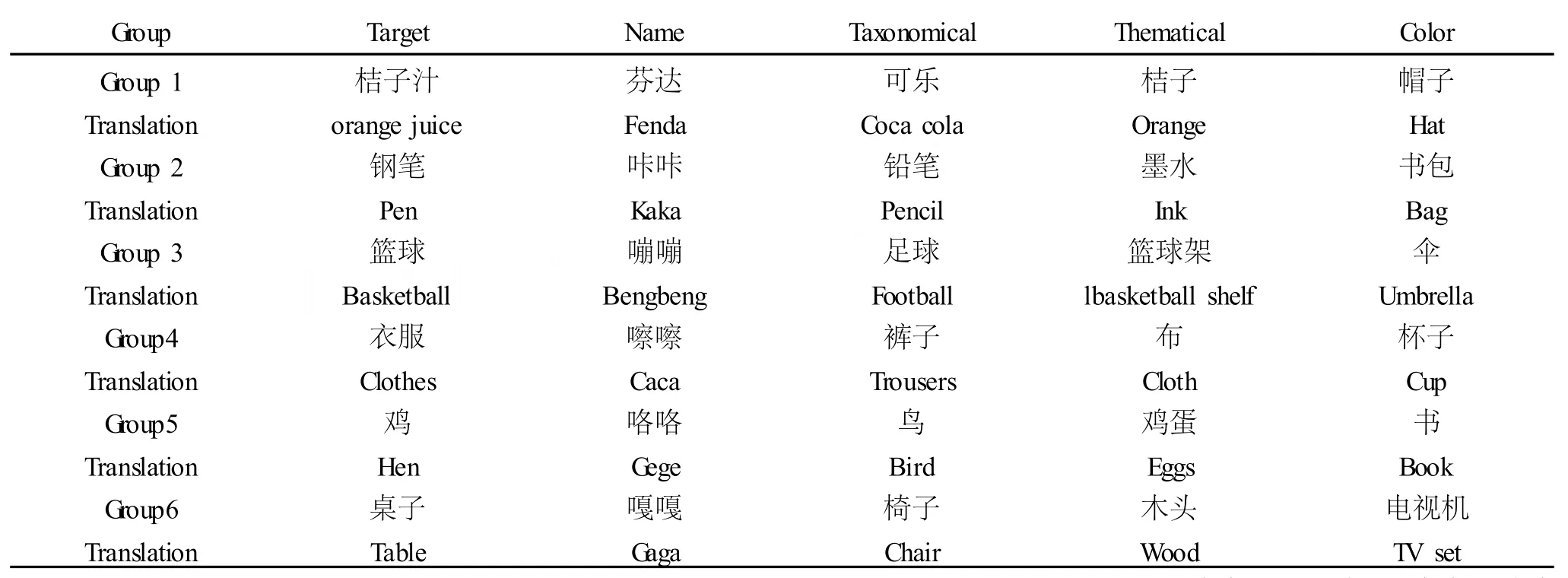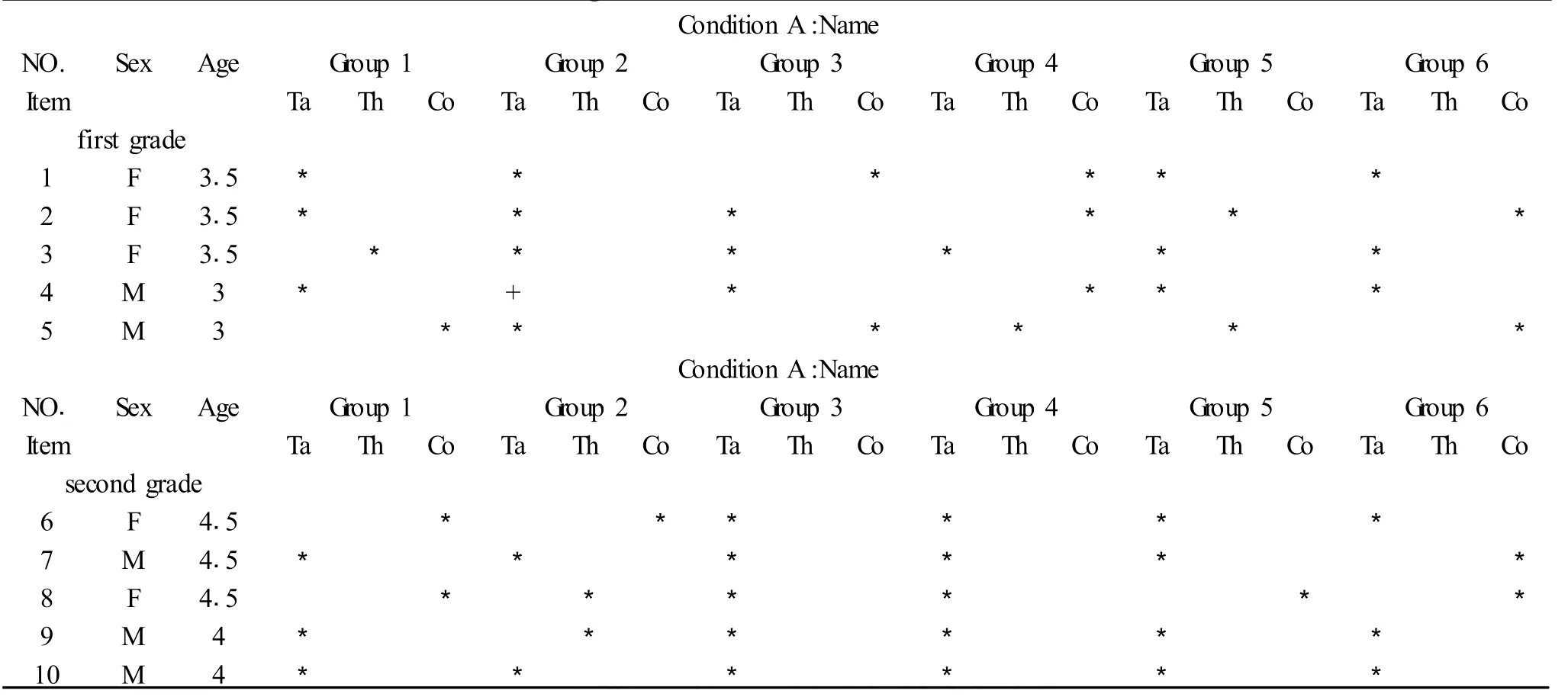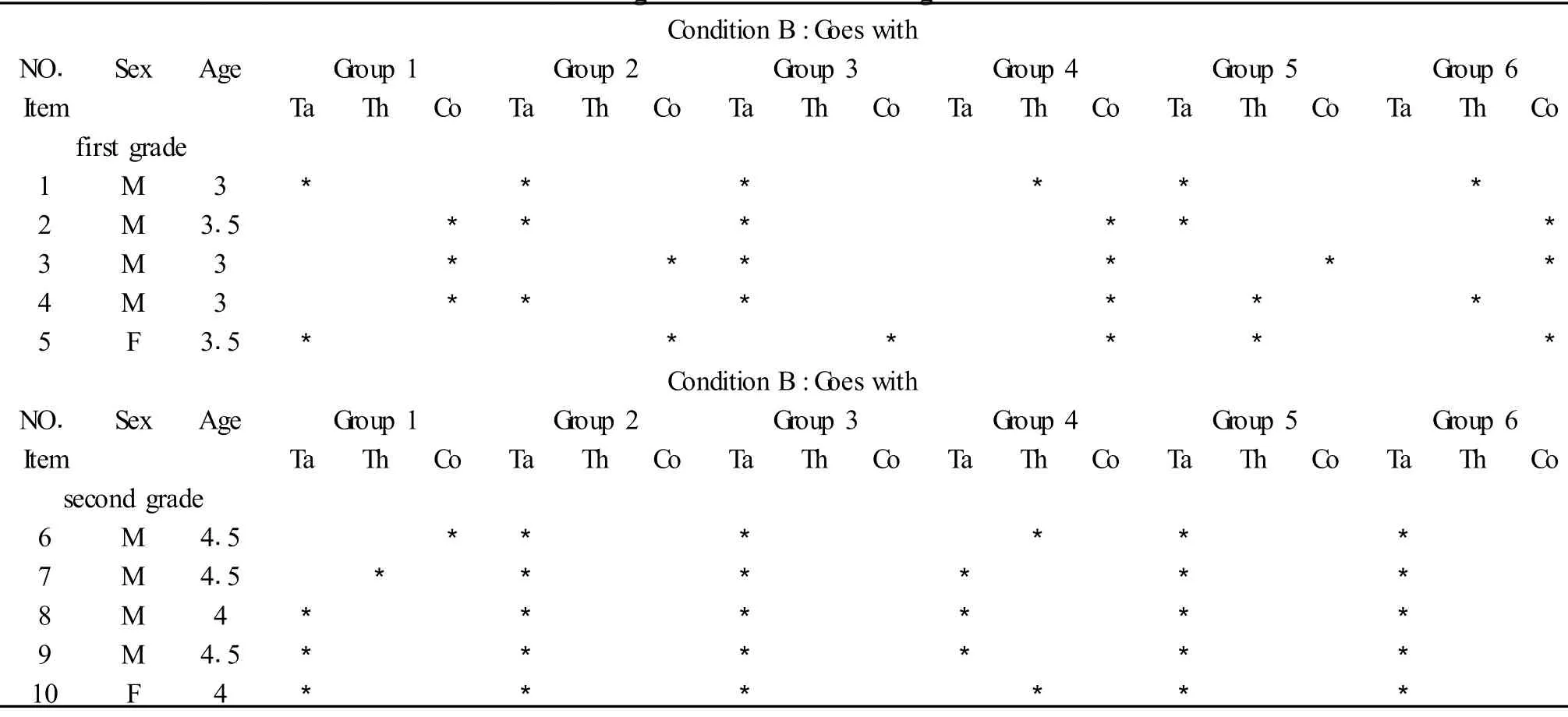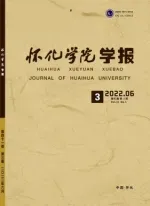Experimental Study on Childrenπs Taxonomic Bias
2010-11-08YANGGaoyunWANRuifangLINa
YANG Gao-yun, WAN Rui-fang, LI Na
(Quality of Humanity Education Department,Yueyang Vocational and Technical College,Yueyang,Hunan 414600)
Experimental Study on Childrenπs Taxonomic Bias
YANG Gao-yun, WAN Rui-fang, LI Na
(Quality of Humanity Education Department,Yueyang Vocational and Technical College,Yueyang,Hunan 414600)
The present study explored the possibilities of children at the mean age 3 and 4 extending object names and how the taxonomic bias is specific to naming.The experiment,in all,focus on two groups.Each group is ten.The mean age of one group is 3,divided into two parts:five of them select a taxonomical match to a target object with a novel name,another five without a name.The other is 4.The process is the same with above-mentioned.The result showed the childrenπs tendency to abide by taxonomic bias.
the taxonomic bias; children; experimental study
Introduction
Children tend to extend object names on the basis of sameness of taxonomic categorization rather than size,color,or material-a tendency that has been dubbed the“taxonomic bias”“Is the taxonomic bias the result of well-learned associations between words and objects?”“Or does it exist because of a general belief that taxonomic category is a good indicator of object specific to naming.The present study addressed this debate by exploring whether the taxonomic bias is specific to naming.
What is the nature of this bias?Taxonomic organization is the grouping together of objects of the same type,and is often contrasted to thematic organization,or the grouping of things on the basis of the relations between them.The definition of taxonomic bias is given by Markman in 1994[1]is as follows:Labels refer to objects of the same kind rather than to objects that are thematically related.Two objects are thematically related if they are linked by some relation-causal,temporal,spatial,or other.
Children has the tendency to extend object names on the basis of sameness of taxonomic categorization rather than size,color,or material-a tendency that has been dubbed the“taxonomic bias”
Researchersdefined:Taxonomic organization isthe grouping together of objects of the same type,and is often contrasted to thematic organization,or the grouping of things on the basis of the relations between them.For instance,objects with similar properties(e1g1feathered things which fly)would be grouped together taxonomically,while groupings which are spatially or causally related,like bookΠtable(related by ON)or ballΠwindow(related by BREAK),are organized thematically.
Naming the objects with nonsense nouns increases the proportion of taxonomic choices[2-3],even among children as young as 21 months[4].Different instructions also appear to elicit different types of matching.Markman[5]shows that the consequences of children being unable to categorize taxonomically would be dramatic and bizarre,as they might have,for instance,ball and window as part of the same category.He proved if labels invite children to form categories,one would predict that in the no-word condition children would randomly choose eitherthe thematically orthe taxonomically related picture,while in the novel-word condition they would prefer the taxonomically related picture.In fact,children in the no-word condition make a taxonomic choice only 25%of the time;that is,25%of the time they chose the categorically related object(pig for the target cow).By contrast,children in the novel-word condition make a taxonomic choice 65%of the time.Since the difference between the two conditions was the presence versus the absence of a label for the objects,it must be the presence of the word that influences childrenπs taxonomic choice.
Markman and Hutchinson[2]formulated a special constraint on word learning in order to explain these results.This constraint leads children to prefer a taxonomic way to thematic way,if they believe they are learning words.The taxonomic bias,therefore,would appear to be specific to the domain of language.
Inspired by Markman and Hutchinson[2]πs experiment,we followed suit in the design of experiment to verify their proposal in the condition of Chinese children and find out how specific the taxonomic bias on both condition of name and goes-with.We tested two groups of children(Study 1 and Study 2)at mean age of 3-year-olds and 4-year-olds.For increasing the validity of the experiment,we created another choice item(color match).Then each child has the 33%possibility to choose any one of the 3 items:taxonomical,thematic,color match.
Study 1
The purpose of study 1 was to examine the role of taxonomic bias in guiding 10 children to identify the objects in the name and go with conditions.As described earlier,Markman[5]demonstrated that children in the novel-word condition make a taxonomic choice 65%of the time.Since the difference between the two conditions was the presence versus the absence of a label for the objects,it must be the presence of the word that influences childrenπs taxonomic choice.In this experiment,we examined this issue more specifically by contrasting childrenπs category bias with a novel name versus go with condition.Children were presented with target objects that possessed a taxonomical-related,a thematically-related and color-related property with other three objects.The focus was on taxonomic bias,as opposed to other types of perceptual similarity.We expected that children would use taxonomic bias to guide their generalization.
Method
The main study is the investigation of 10 children.In addition,four postgraduate female researchers and preschool teachers participated in the task in which they recorded the research results in the experiment.
Participants.Ten 3-year-olds participated in this study(M=313;range=310-315).These were 4 girls and 6 boys.All children were recruited from preschools in Tong Shenghu International Experimental School.Only children with written parental permission participated in the study.
Materials.Six groups of pictures were especially created for this study.Each set consisted of a target picture,a taxonomical-related picture(Ta),a thematically-related picture(Th)and a picture similar in color to the target(Co).Table1 displays the objects on the pictures and questions of the stimuli.

Table 1 The objects on the pictures and questions of the stimuli
Design.Children were randomly assigned to one of two conditions:(a)name,or(b)goes with.Five children participated in each the conditions.The average ages of children in the two conditions didnπt differ significantly.Approximately the same number of boys and girls participated in each condition.
Procedure.Children were tested individually by four postgraduate female researchers in a quiet classroom of their preschools with their teachers organizing them.The basic procedure for the two conditions was similar.The experimenter showed children the target picture of the first stimulus group,described it according to the childπs condition,presented the three test pictures together in a random left-to-right position,and asked the child to choose one of the test pictures.All children were tested in Chinese.The instructions are as follows:
In the name condition,the experimenter showed children the target picture and named it with a novel name by saying,“小朋友 ,请看 ,这是芬达。”(Look at this.Itπs a Fenda.See,itπs a Fenda.This is a Fenda.).She then presented the three test pictures and asked the children,“请在下面三幅图片中找出另外一个芬达。”(Please find out anther Fenda in these three pictures.)
In the goes-with condition,the experimenter showed children the target picture by saying,“小朋友,请看这个。”(Look at this.See this.).She then presented the three test pictures and asked the child,“请在下面三幅图片中找出与这个一致的。”(please find out one of these(pointing to the test pictures)goes with this(the target).In the two conditions,this procedure was repeated for the six sets of pictures for each child.
The novel names were the following meaningless Chinese sounding words:芬达(Fenda),咔咔(Kaka),嘣嘣(Bengbeng),嚓嚓(Caca),咯咯(Gege),and嘎嘎(Gaga).
Study 2
Method
Participants.Ten 4-year-olds participated in this study(M=413;range=410-415).There were 7 boys and 3 girls.All children were recruited from preschools in Tong Shenghu International Experimental School.Only children with written parental permission participated in the study.
Materials.The same six groups of pictures used in Study 1 were used in Study 2.The sets consisted of a target picture and three test pictures:a taxonomically-related one,a thematically-related one and a color match.
Design.Ten children were randomly assigned to one of two conditions:(a)name or(b)goes with.The average ages of children in the two conditions were not significantly different.
Procedure.The procedure in the two conditions was exactly the same as in Study 1.
Results
The alternative hypotheses for Study 1 and Study 2 concerned whether the taxonomical bias would be manifested only in the name condition or whether it would show up in both the name condition and the goes-with condition.To address these hypotheseswe calculated the mean numberof taxonomically-related selections made by children in the different conditions.Table 2 and Table 3 were the choices of the children in the firstgrade and second grade from kindergarten on both Condition A(Name)and Condition B(G oes with).

Table 2 The choices of the children in the first grade and second grade from kindergarten on condition A-name condition

Table 3 The choices of the children in the first grade and second grade from kindergarten on condition B-goes with
According to Table 2 and Table 3,we calculated the sum of childrenπs choices in the two studies.Table 4 was the details.

Table 4 The sum of childrenπs choices in the two studies
From Study 1,we learned that the taxonomical bias of children at mean age of 3 years old is specific to name condition.Children chose taxonomically-related pictures 60%of the sets,more than 33%selection by chance.Thus,only children in the name condition should reveal a preference for category.According to the category-as-cue account,childrenπs taxonomical bias reflects their beliefs about abject categories.Thus,children in the name conditions should reveal a preference for category.Consistent with both theories,and with previous research(e.g.,Landau et al.,1988),children manifested a taxonomical bias when extending names and didnπt do so when simply asked to“choose one that goes with”the target.As Table 4 indicates,in Study 1,However,in the goeswith condition,children selected the taxonomicalpicture(37%)only 4%more than expected by chance,even less than color match(47%).We cannot exclude the possibility that children in go-with condition made the taxonomical decision at chance level.Study 1 verified the Markman and Hutchinsonπs experiment.These findings are important because they indicate that the present stimuli were comparable to stimuli used in previous work.
From Study 2,the case is totally different.Childrenπs taxonomical bias is still specific to name condition.Replicating the previous study,children chose 73%of the sets,much higher than that in thematic and color condition.This result perfectly proved that children have taxonomical bias when they get to learn a novel word.However,on the contrary to the results of Markman and Hutchinson[2]πs experiment,in the goes-with condition,children still have taxonomical bias with a high rate of 87%.Our ad hoc explanationfor thisfinding is the gap between name and goes-with condition is gradually bridged with the increase of age.(for first grade:mean difference=114,p=01178;for second grade:mean difference=018,p=01332,although the p value doesnπt fall in between 0101 and 0.05 for quite limited data in our studies,we can still resort to the change occurring between 2 age groups).Whatπs more,in these two studies with the same materials and design,only the average age of the children is different.One possibility is the age which causes the difference,but it is still not proved and supported by anyother experiments and theories.So we can only make a conclusion that taxonomical bias is specific to name condition without question,but it matters in goes-with condition when the language gets mature.
Discussion
The focus of this research was the theoretical debate surrounding childrenπs tendency to name objects based on their category.The category-as-cue account makes two claims about the underlying reason for this bias.The first claim has to do with the origin of the bias.In particular,the claim is that as children learn countnouns,they learn that these nouns commonly extend to objects that are similar in category to one another.The second claim has to do with the process by which children extend novel names to novel objects.Specifically,the argument is that once the association between count nouns and novel name is driven by non-strategic mechanisms of attention.Two empirical predictions derive from this account.The first prediction is that the taxonomical bias is specific to the context of naming,certainly by 3 years of age,and by most accounts until 4.The second prediction is that the bias should grow stronger between the ages of 3 and 4 years.
The present two studies did not address the origin of the bias.Instead,they focused on how specific it is.The results of the studies supported the category-as-cue proposal.Study 1 revealed that 3-year-oldsπtendency to select a taxonomical match to a target object when asked to extend the targetπs name was similar to that manifested when asked to select an object of the same kind as the target.In that study,children showed no such tendency when asked to select an object that goes with the target.Study 2 revealed that 4-year-oldsπtendency to select a taxonomical match to a target object both in the name condition and goes with condition.
Children are often described as smart word learners.One of the most exciting research programs of recent years has been the attempt to show that this smart word learning is actually rooted in“dumb”associationist mechanisms of learning.This proposalhasmany positivefeatures,especially thatof parsimony.But there is a growing body of evidence,including the studies presented here,that supports a very different view.The intelligence of childrenπs word learning and word use is the productof their considerable linguistic and conceptual competence-in the domains studied here,their understanding of count nouns andof object categories.Children are smart word learners because,in at least some domains,children are smart.
[1]Markman,E.M.(1994).Constraints children place on word meanings.In P.Bloom,ed.,Language acquisition.Cambridge,Maal:MIT Press.
[2]Markman,E.M.and J.E.Hutchinson.(1984).Childrenπs sensitivity to constraints on word meaning:Taxonomic vs.thematic relations.Cognitive Psychology 16,1-27.
[3]Waxman,S.R.&K osowski,T.(1990).Nouns mark category relations:T oddlersπ and preschoolersπ word-learning biases.Child Development.61,1461-1473.
[4]Waxman,S.R.,&Hall,D.G.(1993).The development of a linkage between count nouns and object categories:Evidence from fifteen-to twenty-one- month-old infants.Child Development,64,1224-1241.
[5]Markman,E.M.(1989).Categorization and naming in children:Problems of induction.Cambridge,MA:MIT Press.
[6]Baldwin,D.A.(1991).Infantsπcontribution to the achievement of joint reference.Child Development,62,875-890.
[7]Guasti,M.T(2002).Language Acquisition-the Growth of Grammar.A BradfordBook,theMIT Press,Cambridge,Massachusetts London,England.55-96.
[8]Gelman,S.A&Bloom,P.(2000).Y oung children are sensitive to how an object was created when deciding what to mean it.Cognition,76,91-103.
2010-08-17
杨高云 (1969-),女,湖南岳阳人,岳阳职业技术学院人文素质教育部副教授,硕士,从事应用语言学及英语教学方面的研究。
儿童分类偏好的实验研究
杨高云, 万瑞芳, 李 娜
(岳阳职业技术学院人文素质教育部,湖南岳阳414600)
本实验研究了3-4岁幼儿发展物体命名的可能性和给物体命名有怎样的分类偏好。本实验主要研究了两组儿童,每组10个人。一组的平均年龄是3岁。他们被分成两组,其中五个选择目标物体具有新名字的分类,另五个没有名字。另一组平均年龄是4岁,实验程序同上。实验结果显示儿童的倾向符合分类偏向。
分类偏好; 儿童; 实验研究
H08DocumentA
1671-9743(2010)08-0096-04
万瑞芳 (1966-),女,湖南岳阳人,岳阳职业技术学院护理系讲师,从事英语教学方面的研究。
李 娜 (1975-),女,湖南岳阳人,岳阳职业技术学院商贸物流系副教授,从事应用语言学及商务英语方面的研究。
